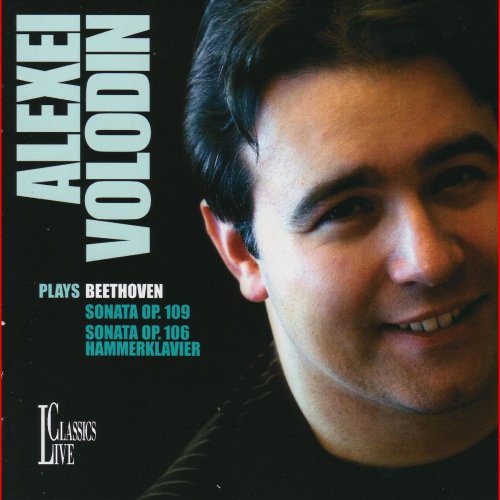
Alexei Volodin - Beethoven: Piano Sonatas (2008)
BAND/ARTIST: Alexei Volodin
- Title: Beethoven: Piano Sonatas
- Year Of Release: 2008
- Label: Live Classics
- Genre: Classical Piano
- Quality: flac lossless (tracks)
- Total Time: 01:06:33
- Total Size: 196 mb
- WebSite: Album Preview
Tracklist
01. Piano Sonata No. 30 in E Major, Op. 109: I. Vivace ma non troppo / Adagio espressivo-II. Prestissimo
02. Piano Sonata No. 30 in E Major, Op. 109: III. Andante molto cantabile ed espressivo
03. Piano Sonata No. 29 in B-Flat Major, Op. 106 "Hammerklavier": I. Allegro
04. Piano Sonata No. 29 in B-Flat Major, Op. 106 "Hammerklavier": II. Scherzo. Assai vivace
05. Piano Sonata No. 29 in B-Flat Major, Op. 106 "Hammerklavier": III. Adagio sostenuto
06. Piano Sonata No. 29 in B-Flat Major, Op. 106 "Hammerklavier": IV. Largo-Allegro risoluto
Young Russian pianist Alexei Volodin here plunges into two of Beethoven's late masterpieces, the difficult Piano Sonata No. 30 in E minor, Op. 109, and the off-the-charts Piano Sonata No. 29 in B flat major, Op. 106, "Hammerklavier." There's no doubt about it; he's technically equipped for the task. The blistering, thorny final fugue of Op. 106, which Beethoven correctly foresaw as something written for the pianists of centuries hence, is fast and crystal clear, its trills echoing sharply through the contrapuntal structure. The arpeggios-over-low-left-hand trill climax of the finale of Op. 109 is confidently executed. What's less clear is whether his interpretive equipment is keeping pace at this point. There's plenty of excitement but less overarching thinking. The opening movement of Op. 109 has an impromptu flavor that bleeds over into the variation set; Volodin breaks off too quickly from the clear variation structure and reduces the impact of the final virtuoso outburst. The echo effects of the second-from-last variation (not including the return of the theme) are overdone, with the quieter passages dissolving into indistinctness. The opening movement of the "Hammerklavier" has ringing power at the beginning but lacks focus as it develops, although the big, bleak slow movement, taken at a rather moderate tempo, holds together over its heavenly length. The mysterious parade of discarded ideas at the beginning of the finale is almost shapeless. This disc was recorded for a new venture called Classics Live, which offers online concerts by orchestras and now, apparently, instrumentalists from around the world. It's not quite clear what is meant by the "live" designation attached to Op. 109; there was no crowd present. Perhaps it, but not the Op. 106 performance, was recorded during the streaming concert without further intervention.
01. Piano Sonata No. 30 in E Major, Op. 109: I. Vivace ma non troppo / Adagio espressivo-II. Prestissimo
02. Piano Sonata No. 30 in E Major, Op. 109: III. Andante molto cantabile ed espressivo
03. Piano Sonata No. 29 in B-Flat Major, Op. 106 "Hammerklavier": I. Allegro
04. Piano Sonata No. 29 in B-Flat Major, Op. 106 "Hammerklavier": II. Scherzo. Assai vivace
05. Piano Sonata No. 29 in B-Flat Major, Op. 106 "Hammerklavier": III. Adagio sostenuto
06. Piano Sonata No. 29 in B-Flat Major, Op. 106 "Hammerklavier": IV. Largo-Allegro risoluto
Young Russian pianist Alexei Volodin here plunges into two of Beethoven's late masterpieces, the difficult Piano Sonata No. 30 in E minor, Op. 109, and the off-the-charts Piano Sonata No. 29 in B flat major, Op. 106, "Hammerklavier." There's no doubt about it; he's technically equipped for the task. The blistering, thorny final fugue of Op. 106, which Beethoven correctly foresaw as something written for the pianists of centuries hence, is fast and crystal clear, its trills echoing sharply through the contrapuntal structure. The arpeggios-over-low-left-hand trill climax of the finale of Op. 109 is confidently executed. What's less clear is whether his interpretive equipment is keeping pace at this point. There's plenty of excitement but less overarching thinking. The opening movement of Op. 109 has an impromptu flavor that bleeds over into the variation set; Volodin breaks off too quickly from the clear variation structure and reduces the impact of the final virtuoso outburst. The echo effects of the second-from-last variation (not including the return of the theme) are overdone, with the quieter passages dissolving into indistinctness. The opening movement of the "Hammerklavier" has ringing power at the beginning but lacks focus as it develops, although the big, bleak slow movement, taken at a rather moderate tempo, holds together over its heavenly length. The mysterious parade of discarded ideas at the beginning of the finale is almost shapeless. This disc was recorded for a new venture called Classics Live, which offers online concerts by orchestras and now, apparently, instrumentalists from around the world. It's not quite clear what is meant by the "live" designation attached to Op. 109; there was no crowd present. Perhaps it, but not the Op. 106 performance, was recorded during the streaming concert without further intervention.
As a ISRA.CLOUD's PREMIUM member you will have the following benefits:
- Unlimited high speed downloads
- Download directly without waiting time
- Unlimited parallel downloads
- Support for download accelerators
- No advertising
- Resume broken downloads


